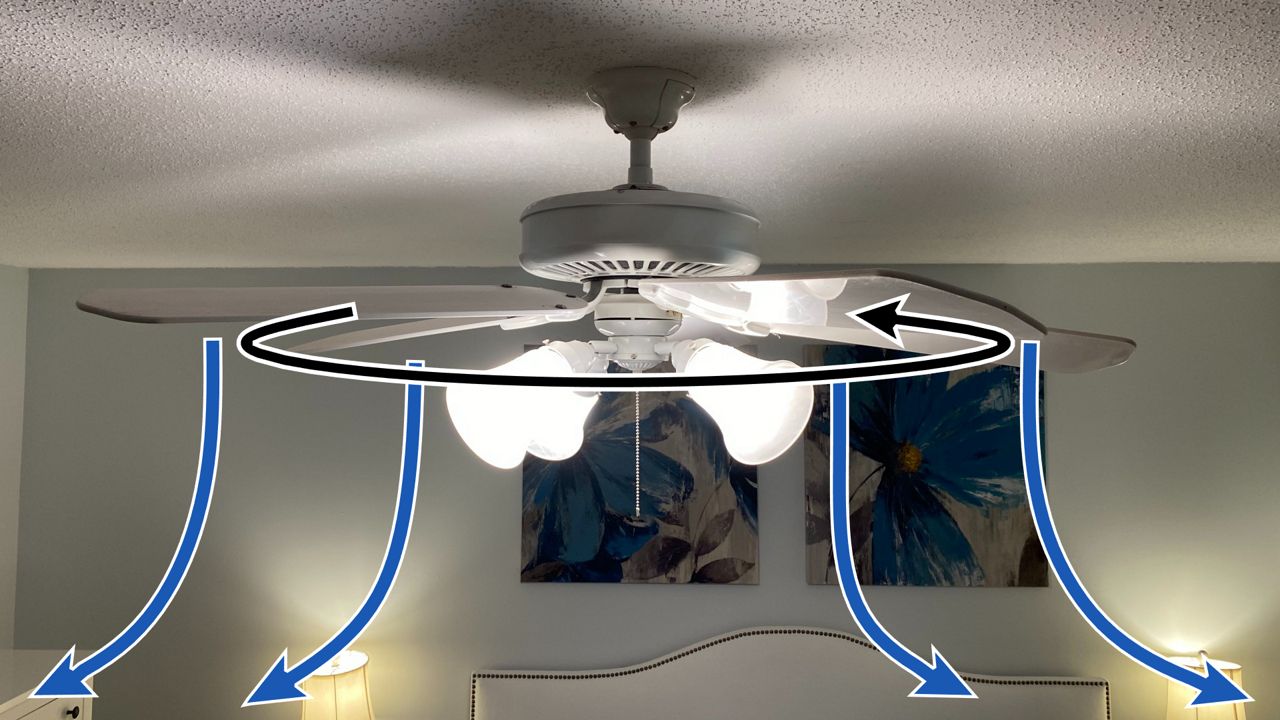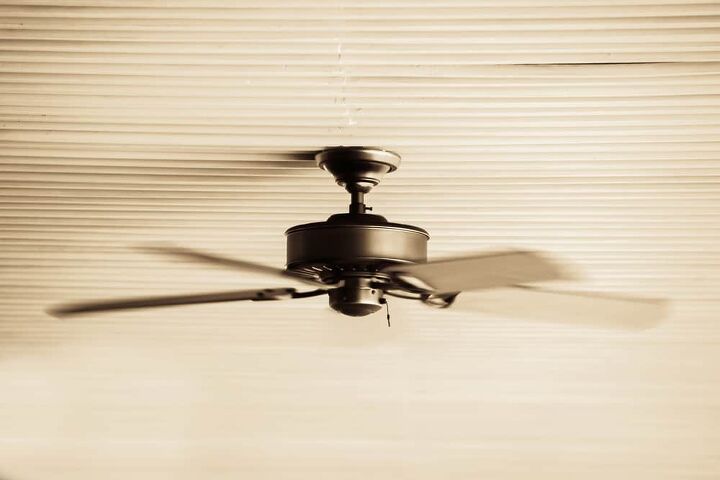How To Change To Slow And Fast Speed Of The Ceiling Fan
Ceiling fans play an important role in every house in every season. All the same, this is just possible if the fan is running properly. It is very annoying when the fans in your house run slowly during the summer season. If this happens, we have found several possible solutions. Before that, let'due south expect at the reasons for the fans to spin slowly. Let'due south learn how to make a ceiling fan spin faster.
Why practice Ceiling Fans accept such a long time to spin?

For a diversity of reasons, your fan may spin slowly. This is due to a lack of lubricant or a faulty capacitor in certain cases. Ceiling fans that have corroded bearings and bushings may likewise rotate slowly; otherwise, your fan'southward speed controller may disconnect or go incompatible with it. Dust nerveless on the fan blades might as well be the cause.
- Lack of lubrication
- Faulty capacitor
- Corrosion of bearings and rings
- Incompatible speed controller
- Dusty blades
How to Make a Ceiling Fan Spin Faster

Make clean the blades
If dust gets on the blades, the blades will get a niggling heavier. As a result, the fan may not rotate every bit expected. You will need to clean the fan blades at regular intervals to foreclose this. If you clean the blades, the weight of the grit is removed, and the fan starts to rotate quickly.
Lubricate the fan
If the fan rotates slowly with squeaking noises, some parts are not properly lubricated. In this case, you volition need to fill up the fan with oil. Get a stepladder and a canvas to protect the floor. Place the plate under the fan and then place the ladder on it. And so climb the ladder and look for a hole in the fan where yous could add oil. Add the oil slowly. Later on calculation the oil, showtime the fan later on a while.
Replace the capacitor
The condenser is connected to the fan mainly to offset the fan. Information technology tin too control the fan speed. Individual capacitors or several capacitors are connected in parallel depending on the fans. Merely due to excessive employ, the wear of the capacitor can be damaged.
It is therefore recommended to replace it. To supercede the capacitor, disconnect the fan from the power supply, bank check the specifications of the existing capacitor and buy a new one. Finally, supervene upon the new one with the old one, connect the fan to the ability supply and start it.
Repair or replace the speed controller
Sometimes the speed controller connected to the fan may non be compatible with the fan or may be asunder. Check if it is connected or not. If you are sure it is connected, consider reprogramming or replacing it.
Repairs of bearings and bushings
The bearings and bushings are easy to replace if you notice that the fan is slowly rotating due to them. This will assistance the fan move faster subsequently removing one-time bearings and bushings and replacing them with new ones.
Dull fan troubleshooting
With the fan off and on, plough the fan blade by manus. A difficult-to-rotate blade indicates a problem with the bearing or lubrication. If the blade rotates freely, plow on the fan and listen to the blade accelerate to full speed.
Whatsoever unusual buzzing would indicate a bad capacitor, shorted winding, or fan running on the wrong blazon of cruise control. Nigh fans are not compatible with solid-country speed command, so make certain your fan and speed control are compatible.
A grinding or whistling sound would betoken a problem with the begetting or housing. Finally, visually audit the fan for fluctuations that indicate poor balance.
Brand sure the lubricant is enough.
Larger ceiling fans use the oil independent in the tank, which lubricates the bearing. A small hole in the acme of the motor embrace allows additional oil to be added to the fan if necessary. The hole is ordinarily labeled "add together oil" by the manufacturer. To prevent oil from getting on your furniture or carpets:
- Place a plastic canvass beneath the fan and use a ladder to discover the "add together oil" hole.
- Start past spraying a lilliputian light oil into the hole and letting the fan run for xx minutes.
- Plough off the fan and add oil to the ceiling fan until the tank overflows slightly. This will usually exist SAE fifteen or SAE 10 oil.
- Wipe the fan cover to prevent dripping.
Some fans are made with permanently lubricated encapsulated bearings, and no oil can be added. According to the instructions or from the manufacturer, brand certain you know if your fan has an oil tank.
Balanced for better operation
Improperly balanced blades can cause wobbling, resulting in slower than normal operation. You must measure from the tip of each vane to the ceiling with the fan turned off to evaluate the remainder.
Each end of the sheet should exist at the aforementioned distance from the ceiling if the ceiling is flat. If the difference is more than 1/4 inch, the blades are unbalanced.
Glue a standard metal pad or coin to the top of the bract closest to the ceiling. Make sure the top of the blade is gratuitous of dust, and use about 3 inches of tape to make certain the pad stays in place.
Experiment with the pads on different blades until all the blades are at the aforementioned level and with the ceiling. If your ceiling is sloping or uneven, use a spirit level to measure out the level betwixt the boards.
Bad capacitor identification
Ceiling fans are single-phase motors and rely on capacitors that start and run. Some fans have a combined on-off capacitor, and some have a capacitor for each.
For speed adjustments, other fans employ numerous capacitors. In the circuit breaker box, switch the circuit breaker that supplies your fan to the "off" position. Utilise a ladder and remove the lesser cover of the fan in which the condensers are usually located.
Although the disassembly process differs slightly for different fans, the capacitors can be hands identified. These are pocket-size blackness cubes or silver rollers and volition take a printed microfarad rating on the side. The nominal value of the capacitor will be a number followed by the letters "of."
Look for whatever baloney in the cube or cylinder indicating condenser failure and supercede any that are discolored or swollen. The capacitors are either connected to screw terminals or have wire basics that connect them to other wires. Detach the lacking capacitor and purchase a replacement using the information on the characterization.
Inspect the motor for damaged windings
Partially short-circuited windings are the last pick that could cause the fan to run slowly. The winding is sometimes damaged if the starting capacitor fails, causing the fan to stop and the coils to heat above their limits.
The fan must be removed and completely disassembled to cheque for winding faults. Visually inspect the winding for signs of heat alter or burns. If the copper is strongly colored due to estrus, replace the motor and associated capacitors.
Ofttimes Asked Questions
What is the all-time way to heighten the speed of my ceiling fan?
Cheque the traction concatenation switch on the fan. A bad switch or missing speed setting will cause the fan to slow down. Turn off the fan and permit it stop. Pull the chain and turn the fan to the lowest setting, then listen to the fan motor equally you lot pull the concatenation and go through the progressive speed setting.
What's the matter with my ceiling fan whirling and so slowly?
Ceiling fans that run slower than usual might cause one of four issues. Two of these issues are mechanical: bearing lubrication loss and blade imbalance. The other ii are electrical: either a faulty capacitor or a faulty winding.
Is Volition replacing the condenser increase the fan speed?
Equally you increment the capacity, the fan motor voltage increases, but the capacitor voltage decreases—the fan speed increases. To increase the fan speed, you must increase the capacitor value.
How to slow downwardly the ceiling fan speed?
Y'all tin add a resistor, capacitor, or inductor in serial with the fan permanently. This increases the overall impedance and reduces the electric current, reducing the fan speed. Another option is to charge the capacitor in the auxiliary winding from 2.25 mfd to say 1.85 or two mfd. This reduces the fan speed.
Can we use ii capacitors in the ceiling fan?
Generally, two serial-parallel capacitors are used in the ceiling fan. The motor is a "two-value capacitor motor" or a "permanent split capacitor motor. "Here, a loftier-capacity capacitor will be connected to the starting winding of the carve up-phase induction motor.
Without a chain, how do I control the speed of my ceiling fan?
To control the fan speed without a switch, you must supply electric current to the appropriate wires to reach the desired speed. Since this is probably a mechanical (not electronic) device, the but way to change the settings is to physically move the switch to another position.
What's the deal with my fan only operating at high speed?
When the fan resistance fails, the highest fan speed is usually the merely i that nonetheless works because information technology essentially bypasses the resistance and receives the maximum voltage. When the resistor is running, it reduces the amount of voltage, leading to lower fan speeds to rotate more slowly.
Determination
We believe y'all accept the reply to your doubts about how to spin up the ceiling fans faster. Also, remove onetime bearings and bushings and replace them with new ones to help the fan spin faster.
Source: https://homeaffluence.com/how-to-make-a-ceiling-fan-spin-faster/
Posted by: dejesuswhind1980.blogspot.com

0 Response to "How To Change To Slow And Fast Speed Of The Ceiling Fan"
Post a Comment